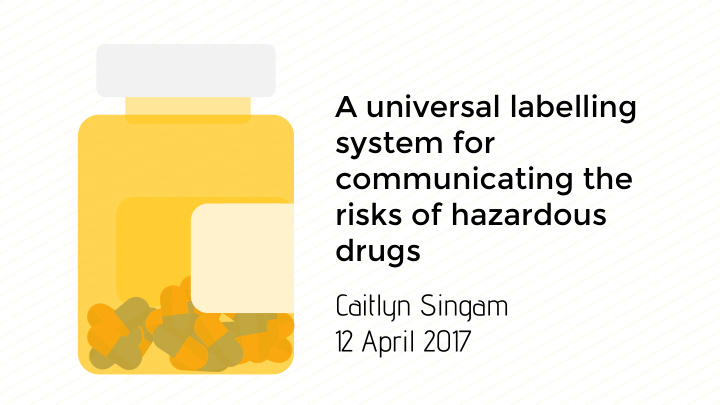



A universal labelling system for communicating the risks of hazardous drugs Caitlyn Singam 12 April 2017
Background • Danger posed by mishandled drugs often overlooked • Used in treatments for cancer, rheumatoid arthritis, lupus, nephritis, multiple sclerosis • Lapse in handling procedure can be dangerous, not reflected by exterior label • Practitioners may overlook due to large number of prescriptions handled • Patients may not understand jargon
Cyclophosphamide • Requires use of impervious gloves when handling packaging • IARC Group 1 carcinogen; FDA Pregnancy Category D
Azathioprine 0 Azathioprine tablets – requires precautions when cut • or crushed • ARC Group 1 carcinogen, FDA Pregnancy Category D
abacavir ganciclovir progrestrone ambrisentan icatibant ribavirin alefacept lefunomide raloxifene bosentan lomitapide riociguat carbamazepine lenalidomide risperidone cetrorelix macitentan telavancin apomorphine liraglutide sirolimus clomiphene mifepristone temazepan Over azathioprine spironolactone clonazepam misprostol topiramate 200 different drugs cidofovir cyclosporine deferiprone are considered hazardous dexrazoxane oxcarbazepine teriflunomide colchicine oxytocin valproate divalproex palifermin thalidomide dronedarone paroxetine voriconazole entecavir paliperidone tofacitinib dutasteride pasireotide warfarin estradiol phenytoin valganciclovir fluconazole peginesatide ziprasidone fosphenytoin pipobroman zidovudine ganirelix plerixafor zonasamide
Problem R x Patient Manufacturer Transport Pharmacy Dispensing Disposal and family
As many as 8 million healthcare workers have the opportunity for hazardous drug exposure in the workplace -NIOSH/CDC, 2016
Proposed solution ! • Clear display of whether a drug is hazardous • Two labelled categories • Infant icon = pregnancy risk • Exclamation mark = general risk (all individuals) ! • Intentionally simplistic – conveys presence of danger • Encourages careful handling, deference to appropriate safety procedure
!
Rationale ! • Attention getting, universally understandable • Healthcare background not required for comprehension • Inverted triangle was found to best convey a sense of danger • Activates amygdala • Unconsciously interpreted as danger, attracts attention to label • Red and yellow chosen due to natural association with danger • Presence of label makes danger more concrete than a description does
Sources • OSHA on hazardous drugs https://www.osha.gov/SLTC/hazardousdrugs/controlling_occex_hazardousdrugs.html • Risk of exposure to hazardous drugs http://www.nursingworld.org/MainMenuCategories/ANAMarketplace/ANAPeriodicals/OJIN/TableofContent s/Volume92004/No3Sept04/HazardousDrugs.aspx#USCommerce https://www.cdc.gov/niosh/topics/hazdrug/default.html • Cyclophosphamide package insert http://www.accessdata.fda.gov/drugsatfda_docs/label/2013/012141s090,012142s112lbl.pdf • Handling of antineoplastic drugs http://hemaonco.tmu.edu.tw/teachingbank/safe_handling/data/proper_technique.html • Shapes that capture attention http://www.mitpressjournals.org/doi/abs/10.1162/jocn.2009.21111 http://psycnet.apa.org/journals/emo/7/3/526/ http://www.sciencedirect.com/science/article/pii/S0031938414003953
pg. 3 of 18 Cyclophosphamide injection package insert
Recommend
More recommend